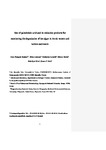Use of palmitoleic acid and its oxidation products for monitoring the degradation of ice algae in Arctic waters and bottom sediments
| dc.contributor.author | Rontani, J-F | |
| dc.contributor.author | Amiraux, R | |
| dc.contributor.author | Lalande, C | |
| dc.contributor.author | Babin, M | |
| dc.contributor.author | Kim, H-R | |
| dc.contributor.author | Belt, Simon | |
| dc.date.accessioned | 2018-09-10T09:02:16Z | |
| dc.date.issued | 2018-10 | |
| dc.identifier.issn | 0146-6380 | |
| dc.identifier.uri | http://hdl.handle.net/10026.1/12272 | |
| dc.description.abstract |
Degradation of palmitoleic acid (C16:1ω7), the main fatty acid component of sea ice-associated (sympagic) diatoms, was monitored in Arctic sea ice at the beginning of ice melting and in the underlying sinking particles and superficial bottom sediments. In sea ice, degradation of sympagic algae involved biotic oxidation induced by 10S-DOX-like lipoxygenase of unknown salinity-stressed attached bacteria, while photo- and autoxidation were limited. In the water column, strong hydratase and Z/E isomerase activity were observed. Hydration of unsaturated fatty acids seems to be a detoxification strategy, which is essential for bacterial survival when associated with free fatty acid-rich environments such as ice algae. In contrast, Z/E isomerisation of palmitoleic acid was attributed to the release of Fe2+ ions during radical-induced damage of the active site of the bacterial 10S-DOX-like lipoxygenase and Z/E isomerases. Due to the poor physiological state of their attached bacteria resulting from salinity stress in brine channels or toxicity of free ice algae fatty acids, sympagic algae appeared to be only very weakly biotically degraded within the water column. In bottom sediments, free radicals resulting from 10S-DOX-like lipoxygenase activity induced a strong autoxidation of the ice algal material. The presence in bottom sediments of a significant proportion of oxidation products resulting from 10S-DOX-like lipoxygenase activity attested to the strong contribution of sea ice-derived OM released during the early stages of ice melt prior to deposition in the sediments. However, on the basis of the highest fatty acid photooxidation state observed in these sediments, an additional contribution of highly photooxidized material (ice algal material released at the end of ice melting or open water phytoplankton) seems likely. The degradation of hydroperoxides, resulting from biotic and abiotic degradation of palmitoleic acid, appeared to involve: (i) homolytic cleavage of the peroxyl group affording the corresponding hydroxy- and oxoacids, (ii) reduction to the corresponding hydroxyacids by peroxygenases, (iii) heterolytic proton-catalysed cleavage and (iv) conversion to allylic 1,4-diols by diol synthases and hydroperoxide isomerases. | |
| dc.format.extent | 88-102 | |
| dc.language | en | |
| dc.language.iso | en | |
| dc.publisher | Elsevier | |
| dc.subject | Palmitoleic acid | |
| dc.subject | Sympagic algae | |
| dc.subject | Arctic | |
| dc.subject | Biotic and abiotic degradation | |
| dc.subject | Sea ice | |
| dc.subject | Sinking particles | |
| dc.subject | Superficial bottom sediments | |
| dc.title | Use of palmitoleic acid and its oxidation products for monitoring the degradation of ice algae in Arctic waters and bottom sediments | |
| dc.type | journal-article | |
| dc.type | Journal Article | |
| plymouth.author-url | https://www.webofscience.com/api/gateway?GWVersion=2&SrcApp=PARTNER_APP&SrcAuth=LinksAMR&KeyUT=WOS:000443952100008&DestLinkType=FullRecord&DestApp=ALL_WOS&UsrCustomerID=11bb513d99f797142bcfeffcc58ea008 | |
| plymouth.volume | 124 | |
| plymouth.publication-status | Published | |
| plymouth.journal | Organic Geochemistry | |
| dc.identifier.doi | 10.1016/j.orggeochem.2018.06.002 | |
| plymouth.organisational-group | /Plymouth | |
| plymouth.organisational-group | /Plymouth/Faculty of Science and Engineering | |
| plymouth.organisational-group | /Plymouth/Faculty of Science and Engineering/School of Geography, Earth and Environmental Sciences | |
| plymouth.organisational-group | /Plymouth/REF 2021 Researchers by UoA | |
| plymouth.organisational-group | /Plymouth/REF 2021 Researchers by UoA/UoA07 Earth Systems and Environmental Sciences | |
| plymouth.organisational-group | /Plymouth/Research Groups | |
| plymouth.organisational-group | /Plymouth/Research Groups/Marine Institute | |
| plymouth.organisational-group | /Plymouth/Users by role | |
| plymouth.organisational-group | /Plymouth/Users by role/Academics | |
| plymouth.organisational-group | /Plymouth/Users by role/Researchers in ResearchFish submission | |
| dcterms.dateAccepted | 2018-06-02 | |
| dc.rights.embargodate | 2019-6-6 | |
| dc.rights.embargoperiod | Not known | |
| rioxxterms.version | Accepted Manuscript | |
| rioxxterms.versionofrecord | 10.1016/j.orggeochem.2018.06.002 | |
| rioxxterms.licenseref.uri | http://www.rioxx.net/licenses/all-rights-reserved | |
| rioxxterms.licenseref.startdate | 2018-10 | |
| rioxxterms.type | Journal Article/Review |


